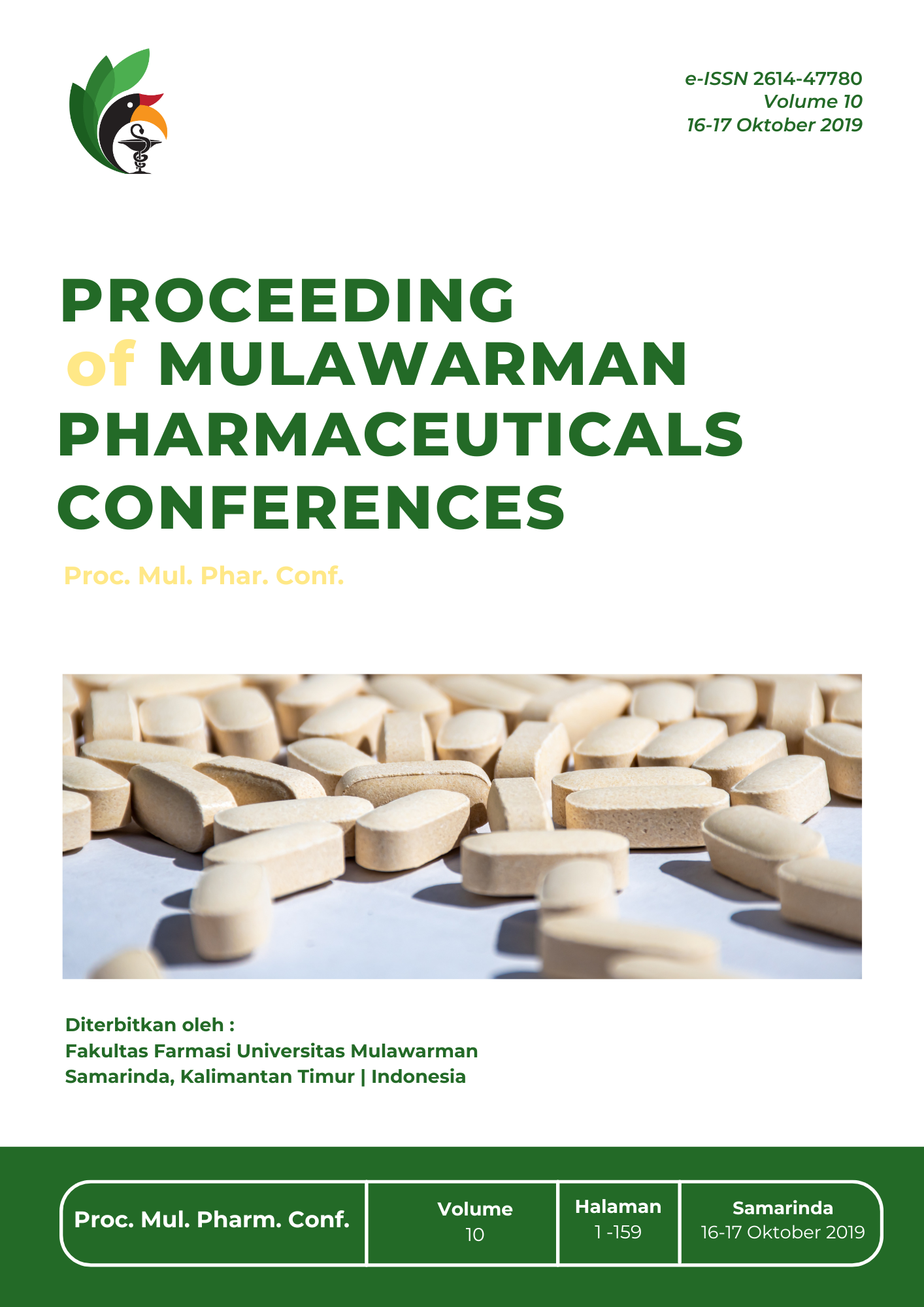Identifikasi Metabolit Sekunder Ekstrak Metanol Akar dan Batang Merung (Coptosapelta tomentosa ) yang Memiliki Aktivitas Antioksidan Menggunakan Metode KLT Autografi
DOI:
https://doi.org/10.30872/mpc.v10i.51Keywords:
antioxidant, DPPH, KLT Autograph, Merung, Coptosapelta tomentosaAbstract
Secondary metabolites produced by plants have been known to have a variety of biological activities including antioxidants that serve to ward off oxidant compounds and free radicals. The roots of merung (Coptosapelta tomentosa) has been known to have strong activity as an antioxidant while antioxidant activity in the stem is not yet known to date. This research aims to determine the secondary metabolites that have antioxidant activity on the root extracts and the stem of the vines qualitatively. The root extract and the stem of the merung plant are extracted with a methanol solvent using the maceration method. Antioxidant activity and identification of secondary metabolites are carried out qualitatively by the method of autography using the 2.2-Diphenyl-1-Picrylhydrazyl compound (DPPH) and some reagents of the secondary metabolite. Antioxidant activity of the merung root extract is on spot with RF 0.08 and 0.66. Spot with the RF 0.66 shows the brown color when reacted FeCl3, fluorescent yellow in UV rays 254 and 366 nm after reacted AlCl3 and red when reacted with KOH. The antioxidant activity of the merung stem extracts is at Rf 0.16, 0.33, 0.58, 0.66, and 0.75. Spot with the Rf 0.16 shows the color of brown when reacted FeCl3 and fluorescent blue in UV rays 254 and 366 nm after reacted AlCl3. Secondary metabolites that have antioxidant activity on root extracts and stems are suspected to be derivative phenolic compounds derived from flavonoid compounds.
References
[1] Kusumowati, Ika Trisharyanti Dian, dkk, 2011, “Korelasi Kandungan Fenolik dan Aktivitas Antioksidan Daun Jambu Mete”, Jurnal Biomedika. Vol. 3 No. 2
[2] Karolina, A, Djihan, R, dan Erwin, 2018, “Uji Fitokimia dan Toksisitas Ekstrak Merung (Coptosapelta tomentosa (Blume)”, Fakultas Matematika dan Ilmu Pengetahuan Alam Universitas Mulawarman, Samarinda
[3] Aprilia, N, Widayat, W, dan Ramadhan, A, 2017, ‘Aktivitas Antibakteri Ekstrak Metanol Akar Tumbuhan Merung (Coptosapelta tomentosa) Terhadap Bakteri Streptococcus mutan’, Proceeding of the 6th Mulawarman Pharmaceuticals Conferences, Fakultas Farmasi Universitas Mulawarman, Samarinda.
[4] Hermanda, R., Widayat, W, dan Rijai, L, 2016, ‘Aktivitas Antibakteri Ekstrak Metanol Akar Tumbuhan Merung (Coptosapelta tomentosa) Terhadap Bakteri Escherichia coli dan Staphylococcus aureus’, Prosiding Seminar Nasional Kefarmasian IV, Fakultas Farmasi Universitas Mulawarman, Samarinda.
[5] Karolina, A, Djihan, R, dan Erwin, 2018, “Uji Fitokimia dan Toksisitas Ekstrak Merung (Coptosapelta tomentosa (Blume)”, Fakultas Matematika dan Ilmu Pengetahuan Alam Universitas Mulawarman, Samarinda
[6] Ferenczi-Fodor, K., Vegh, Z., and Renger, B., 2006, “Thin-layer Chromatography in Testing The Purity of Pharmaceuticals, TrAC Trends in Analytical Chemistry”, Vol. 25 (8), 778-789.
[7] Mudjirahmini, D., dan T, Ersam, 2006, “4-Fenilkumarin pada Fraksi Polar Ekstrak Etil Asetat dari Batang Garcinia Balica Miq”, Seminar Nasional Kimia VIII Surabaya, 8 Agustus 2006.,1-9.
[8] Wagner, H., Badt, S., Zginski, E.M., “Plant Drug Analysis A Thin Layer Chromatography Atlas”, Transleted by Schoot, Spenger Verlag, Tokyo, 1984.
[9] Harborne, J., 1987, “Metode Fitokimia : Penuntun cara modern menganalisa tumbuhan. Terbitan Kedua”, Terjemahan Kosasih Padmawinata dan Iwang Soediro. Bandung : ITB
[10] Wali, M.; Haneda, N. F. dan Maryana, N., 2014, “Identifikasi Kandungan Kimia Bermanfaat pada Daun Jabon Merah dan Putih (Anthocephalus spp.)”, J. Silvikultur Tropika, 5:77-83.
[11] Prakash, A, 2001, A”ntioxidant Activity. Medallion Laboratories-Analytical Progress”, Volume 19, Nomor 2, Hal 1-4
[12] Chang, C. C., Yang, M. H., Wen, H. M., and Chern, J. C, 2002, “Estimation of Total Flavonoid Content in Propolis by Two Complementary Colorimetric Methods”, Journal of Food and Drug Analysis, 10: 178– 182.
[13] T. Sathish kumar, M, Sampath, S, V, Sivachandran, S, Shanmugam and P, Rajasekaran, 2009, ‘Optimal process for the extraction and identification of flavonoids from the leaves of Polyalthia longifolia using L16 Orthogonal design of experiment’, Int. J. Biol. Chem. Sci. 3(4): 736-745.
[14] Susanti, N.M.P., Luh Putu MirahKusuma Dewi, Harlina Setiawati Manurung, I Made Agus Gelgel Wirasuta., “Indentifikasi Senyawa Golongan Fenol Dari Ekstrak Etanol Daun Sirih Hijau (Piper Betle Linn) Dengan Metode KLT-Spektro fotodensitometri”, Jurnal Metamorfosa, 2017: 4(1): 108- 113.
[15] Cos, P., Calomme, M., Sindambiwe, J.B., Bruyne, T.D., Cimanga, K., Pieters, L., Vlietinck, A.J., and Berghe, D.V., 2001, Cytotoxicity and Lipid Peroxidation-Inhibiting Activity of Flavonoids, Planta Med., 67 : 515-519.
[16] Gulcin, I., Uguz, M.T., Oktay, M., Beydemir, S., and Kufrevioglu, O.I., 2004, Evaluation of the Antioxidant and Antimicrobial Activities of Clary Sage (Salvia sclarea L.), Turk I. Agric. For., 28: 25-33.
[17] Amic D, Dusanka DA, Beslo D, Trinasjtic, 2003, ‘Structure-radikal scavengingactivity relationship of flavonoids’, Crotia Chem Acta 76:55-61.
[18] Hasim, dkk, 2017, “Aktivitas Antioksidan Ekstrak Sulur Buah Naga Putih (Hylocereus undatus) dengan Metode DPPH dan Rancimat. Jurnal Gizi Pangan”, Vol. 12 No. 3. ISSN 1978-1059.
[19] Janeiro, P, and A.M.O. Brett, 2004, ‘Catechin electrochemical oxidation mechanism’, Analytica Chimica Acta 518 : 109-115.
[20] Ariningsih, I.; Solichatun, dan Anggarwulan, E., 2003, “Pertumbuhan Kalus dan Produksi Antrakuinon Mengkudu (Morinda citrifolia L.) pada Media Murashige-Skoog (MS) dengan Penambahan Ion Ca2+ dan Cu2+”, J. Biof, 1: 39-43.
Downloads
Published
Issue
Section
License
Copyright (c) 2019 Nurul Yasmin, Wahyu Widayat, Angga Cipta Narsa (Author)

This work is licensed under a Creative Commons Attribution-NonCommercial 4.0 International License.


